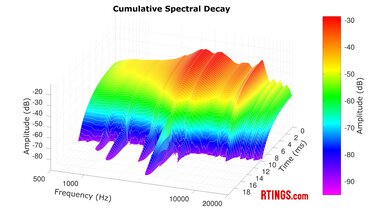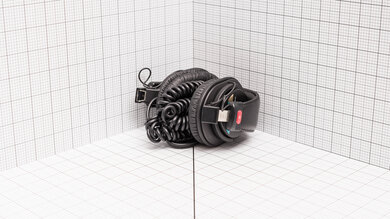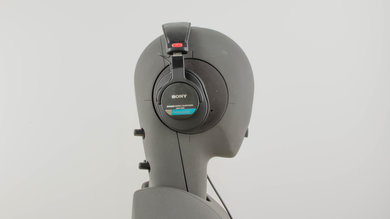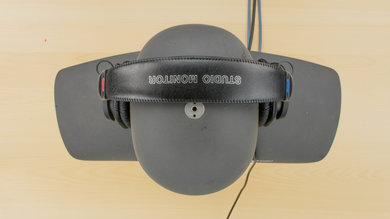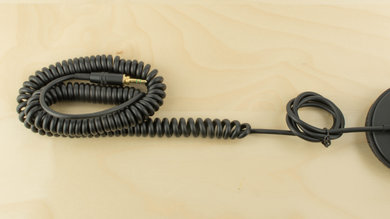The Sony MDR-7506 are comfortable, closed-back headphones well-suited for audiophiles and audio professionals. Since their initial release in 1991, they've remained a permanent fixture in the Sony headphones lineup, thanks to their popularity and wide availability of replacement parts.
Our Verdict
The Sony MDR-7506 aren't designed for sports and fitness use. They're not very stable, so the headband will likely slip off your head if you take them on a jog. They're also not particularly comfortable, and while repairable, they don't feel durable. If your music plays a major part in getting you pumped up, the headphones' lack of bass overall means you'll miss out on thumpy kicks to help you keep your running cadence. The headphones are also wired, which can be a snagging hazard if you're working out in the gym.
Repariable design.
Unstable design.
No IP rating.
The Sony MDR-7506 are disappointing for travel. They don't isolate you from much noise, like subway commuter noise and buses accelerating. Still, they're comfortable enough for long flights as they're relatively lightweight, plus you can plug them into in-flight entertainment systems that support a standard audio jack.
Bad noise isolation.
Unstable design.
The Sony MDR-7506 are bad for office work. The headphones don't have an integrated mic, so you're relegated to your phone or computer's built-in microphone (unless you have a standalone mic) if you need to take meetings or calls. Plus, the headphones don't isolate you from your environment much, which can expose you to distractions in the office if you work in a shared space like a bullpen.
Bad noise isolation.
No integrated mic.
The Sony MDR-7506 are wired-only headphones and aren't suitable for wireless gaming.
The Sony MDR-7506 aren't designed with gaming in mind. They don't have an integrated or boom microphone, which can make communicating with teammates or friends difficult without a standalone mic. They have a bright sound with a relatively elevated treble range, which can make pinpointing details in competitive shooters easier, but their lack of sub-bass renders explosions in cinematics somewhat lackluster. As they use an analog connection with no processing, the headphones also have virtually no latency, so audio/visual desync won't be an issue.
Repariable design.
No integrated mic.
Unstable design.
The Sony MDR-7506 have decent audio reproduction accuracy. The headphones don't have any serious issues in group delay or stereo matching performance, with most issues present on our graphs being inaudible or artifacts. That said, their frequency response deviates from their bright sound profile, particularly in the treble range, which can render neighboring upper harmonics hissy relative to one another. Still, they have impressive harmonic distortion performance, meaning the headphones reproduce your audio cleanly. And while these headphones excite your pinna and provide spatial cues, their PRTF measurements don't resemble those of an angled reference speaker.
The Sony MDR-7506 have bad noise isolation performance. These headphones don't have an active noise cancellation feature and rely solely on their earpads for passive isolation. That said, their earpads don't attenuate much noise. Most low-range noise, like rumble from car engines and construction equipment, won't be blocked by the headphones. And while they perform better at isolating you from higher frequency noise, you'll still make out chatty coworkers or children crying in an airplane cabin. They have decent leakage performance, though, so most people won't be distracted by your favorite tracks, unless you have your volume cranked up in a quiet space.
The Sony MDR-7506 don't have an integrated microphone or a detachable cable, so an aftermarket integrated mic replacement cable won't be an accessible solution.
The Sony MDR-7506 have great frequency response consistency. Your listening experience will likely resemble our frequency response measurements, though you may experience slight differences in bass range delivery depending on your characteristics.
Performance Usages
Changelog
-
Updated Jul 17, 2025:
This review has been updated to Test Bench 2.0, which adds the following tests: Stereo Mismatch, Group Delay, Cumulative Spectral Decay, PRTF, Harmonic Distortion, and Electrical Aspects. In addition, we've added updated results for Isolation, including Noise Isolation - Full Range and Noise Isolation - Common Scenarios. We've added new performance usages and updated the text throughout the introduction, comparisons, and Sound tests and side-by-sides.
- Updated Jul 10, 2025: We've converted this review to Test Bench 2.0, which updates our sound tests and adds performance usages. You can read more about this in our changelog.
- Updated Jul 04, 2025: We've converted this review to Test Bench 1.8, which updates our target curve and Sound tests. You can read more about this in our changelog.
- Updated Jun 27, 2025: We've converted this review to Test Bench 1.7, which updates our Noise Isolation test. We've also expanded the scope of this test to include Common Scenarios in addition to Voice Handling and Wind Handling.
Check Price
Differences Between Sizes And Variants
These headphones have seen no changes or modifications since their release in 1991. They're only available in one colorway: 'Black.' If you encounter another variant, please let us know in the comments, and we'll update our review.
Popular Headphones Comparisons
The Sony MDR-7506 are closed-back over-ear headphones, well-known for their detailed sound. While modern-day headphones are packed with features like noise cancellation (ANC) and virtual surround, these headphones have hardly changed in over 30 years. Like the Audio-Technica ATH-M50x and Beyerdynamic DT 990 PRO, they've become staples in living rooms and recording studios. While the Sony hold their own, the Audio-Technica and Beyerdynamic are more comfortable and better built, and the former has a detachable cable design. In 2023, Sony released the MDR-MV1, a pair of open-backs with obvious nods to the MDR-7506's classic silhouette. They're more comfortable than their closed-back variant, but they produce less bass, which is expected from an open-back driver enclosure.
See our recommendations for the best audiophile headphones and the best over-ear headphones under $100.
The Sony MDR-7506 are slightly better headphones than the Sennheiser HD 280 Pro 2016. Both headphones have a plastic-heavy construction and feature coiled, non-detachable cables. While the Sennheiser provide more passive isolation, they deliver audio more inconsistently. Meanwhile, the Sony are also more comfortable and more portable.
The Audio-Technica ATH-M50x and Sony MDR-7506 are similar headphones targeted toward professional and studio use. The Audio-Technica are more comfortable to wear during long listening sessions, and they feel better built than the Sony MDR-7506. Both are tuned for monitoring and recording audio. The headphones are fairly similar, but you might be able to find the Sony at a cheaper price point, so they might offer better value, even though the Audio-Technica include swappable cables for easy replacement.
The Beyerdynamic DT 770 PRO and the Sony MDR-7506 are both closed-back headphones. While both have a bright sound profile, the Sony have a bit more treble emphasis. Meanwhile, the Beyerdynamic have a better build quality and a more comfortable, stable fit, along with a more open sound. However, the Sony leak much less audio.
The Sony MDR-7506 and the Audio-Technica ATH-M40x are closed-back headphones. The Sony are more consistent among various users and have a repariable design, while the Audio-Technica have a more comfortable and stable fit, and come with two different detachable audio cables.
Test Results

The Sony MDR-7506 have a bright sound profile that more closely resembles the SoundGuys.com Studio Curve. That said, their elevated treble response (even relative to the already bright target curve) makes them less suited for casual listening for most people. Still, the Sony have been a staple over the last three decades for a reason; their elevated high-end facilitates easy identification of pops and artifacts in professional applications.
They have great frequency response consistency. You'll experience consistent audio delivery regardless of your face shape or whether you have long hair or wear glasses. That said, bass delivery varies slightly depending on your characteristics. There isn't much deviation between reseats, so your experience won't vary even if you have to reseat the headphones after a bathroom break.
They have good bass accuracy. The range is underemphasized relative to our target curve, but the headphones have enough bass that you won't be missing too much warmth from kick drums. That said, the frequency response rolloff in the low bass means you'll miss out on rumble, which makes these headphones less-than-optimal for enjoying bassy drops in your favorite EDM tracks.
These headphones have amazing mid-range compliance. The response is tilted upward, but follows our target curve well. Depending on your preferences, you may find instruments like snare drums are slightly thin. In songs like Carole King's You've Got a Friend, the vocals sound both present and intimate, and you can clearly distinguish them against the crisp piano accompaniment.
They have disappointing treble accuracy. Their frequency response throughout the range is elevated. This results in a potentially harsh, piercing, or hissy sibilants and upper harmonics of vocals and instruments, especially when contextualized by the relatively underemphasized bass. That said, the overemphasis in the treble can be useful for professional audio applications as pops, clicks, and other unwanted audio artifacts are more easily identifiable.
The peaks and dips performance is decent. The headphones' frequency response mostly resembles their bright sound profile. The bass range fluctuates more in the treble range, though. In particular, a sharp peak near 10kHz can render the hi-hat in your favorite house tracks hissy.
These headphones have excellent stereo matching. The L/R drivers have almost no overall amplitude mismatch and minor localized frequency and phase mismatches over narrow frequency bands, which won't be audible. In practice, the headphones will clearly reproduce panned elements in a complete stereo image.
The headphones reproduce tight bass and transparent treble. While the graph shows fluctuations in group delay in the bass range, there aren't audible issues in practice, as they're caused by noise floor interactions with our test setup.
The Sony MDR-7506 have disappointing pinna interaction, resulting in PRTF measurements that differ from our target. The headphones can't replicate a stereo speaker listening experience naturally, though they do improve your immersion compared to other types of headphones like IEMs.
The headphones have great harmonic distortion performance. While our graph shows a high percentage of harmonic distortion in the bass range, you likely won't perceive coloration that affects your listening experience, as humans are less sensitive to lower frequencies.
These headphones don't require an amp to drive them; you'll be able to listen to music at a reasonable level without clipping in tracks with greater variety in dynamics, even when connected to a mobile device or laptop.
These are the settings used to test these headphones. Our results are only valid when the headphones are used in this configuration.
The Sony 7506 have a closed-back, over-ear design. A few branding logos highlight the understated, all-black color scheme. The ear cups are large and oval, while the wide headband is lightly padded and covered in a faux leather-like material. There are red and blue accents on opposite sides of the headband, so you can instantly differentiate between right and left.
These headphones are decently comfortable. The ear cups are large enough to fit well around most ears. They also don't grip your head too tightly, so they won't get uncomfortable during long listening sessions. The ear cups are covered with a faux leather material that feels soft but cheaply made. However, they aren't as comfortable as the plush padding seen on the Sony MDR-MV1.
The Sony 7506 are reasonably portable headphones. Their frame is quite bulky, but the foldable design tightly tucks the ear cups within the frame to save space. They won't be the easiest headphones to carry around, but they will comfortably fit into most bags. Unfortunately, they don't come with a pouch or case.
These headphones have a decent build quality. They have a thin metal frame that somewhat reinforces the build, and despite being lightweight, the dense plastic used on the ear cups and yokes is solid enough to withstand being dropped. Overall, these headphones feel cheap, and there's an audible creak when you put them on. The hinges are also relatively weak, and the exposed wire is susceptible to damage. On the upside, these headphones are designed for their parts to be easily replaceable, so you can switch out any damaged parts without buying a new pair.
These headphones have disappointing stability. They won't slide off your ears during casual listening sessions, but you'll have to re-adjust their fit if you find yourself headbanging too hard. If you're looking for more stable studio headphones at a similar price, check out the AKG K361.
The Sony MDR-7506 have poor noise isolation. The headphones aren't equipped with active noise cancelling, so they only block noise through passive isolation. While this provides a degree of attenuation in the treble range, which helps block out sounds like fridge hum, it provides minimal isolation against mid-range noise and virtually no isolation against low-frequency sounds, like engine rumble.
The Sony MDR-7506 are bad at isolating you from noise in common scenarios. They won't do much against rumbly airplane and semi-truck engines. However, they'll offer some respite from the hiss of running water if you work near the office kitchen.
They have decent leakage performance. Escaping audio is concentrated in the mid and treble range, rendering a thin reproduction of your favorite soundtracks. That said, leakage from these headphones isn't particularly loud and won't distract close neighbors unless you have your volume cranked up in a quiet space like a library.
These headphones have a 50 in/1.27 m detachable audio cable. As with most wired headphones, they have virtually no latency, making them a good option for live monitoring a recording session, provided you have minimal latency in the rest of your setup.
You can connect these headphones to PCs with a wired connection for audio compatibility. However, you'll need a standalone mic to input audio.
You can connect these headphones to PlayStation consoles with a wired connection for audio compatibility. However, you'll need a standalone mic to communicate with your teammates.
You can use these headphones wired on Xbox if you plug their 1/8" TRS cable into a controller. However, you'll need a standalone microphone to input audio.

